Leap into the fascinating realm of Later Heaven Bagua, an ancient Chinese system offering profound insights into life's mysteries and reality's fundamental principles.
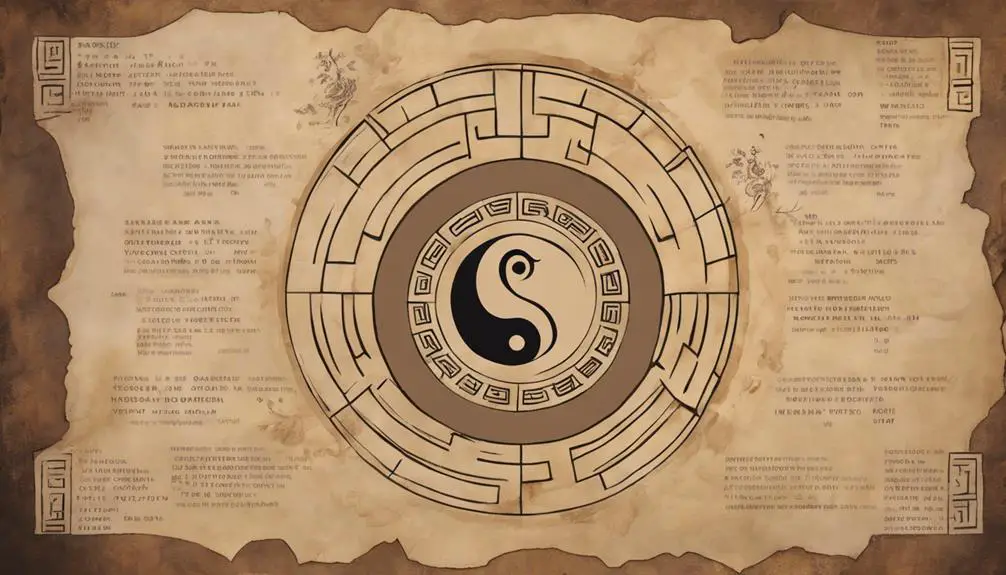
Later Heaven Bagua
While you may find it easy to navigate the physical world, the realm of symbolic, ancient Chinese philosophy may seem like uncharted territory. Yet, you've likely encountered the Later Heaven Bagua, a complex system of symbols and trigrams used in Taoist cosmology and Feng Shui, without even realizing it.
These symbols, deeply rooted in nature, represent fundamental principles of reality and can offer profound insights into life's mysteries. Intrigued? Let's unfold this enigmatic tapestry together, and you'll discover why the Bagua continues to captivate seekers of wisdom after all these centuries.
Key Takeaways
- Later Heaven Bagua, rooted in ancient Chinese philosophy, guides balance, harmony, and influences various fields including architecture and martial arts.
- Comprising of trigrams, Bagua represents fundamental elements like heaven, earth, fire, and water, symbolizing change and transformation.
- Bagua symbolizes the interplay of active and passive forces, providing insights into life's cycles and patterns, facilitating healing and resilience.
- In Feng Shui, Later Heaven Bagua is essential for harmonizing environments, aligning positive energy, and enhancing different life aspects like wealth, health, and relationships.
Origins of the Later Heaven Bagua
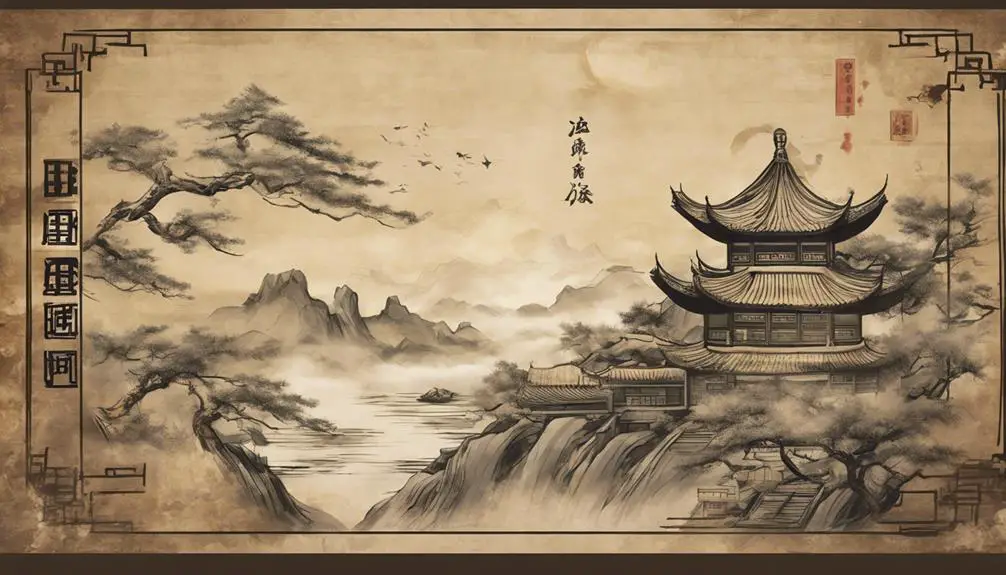
Diving into the origins of the Later Heaven Bagua, you'll discover that it's deeply rooted in ancient Chinese philosophy and cosmology, embodying principles that have shaped countless aspects of Eastern culture for millennia. It's a philosophical compass, guiding concepts of balance, harmony, and energy flow within the universe.
The Bagua's philosophical impact isn't confined to abstract thought. It's been instrumental in shaping practical fields too, from architecture to medicine, and even martial arts. You'll find its influence in the fluid movements and strategic mindsets of fighting styles like Baguazhang. This martial art, which literally translates to 'eight trigram palm', incorporates the Bagua's principles into its technique, emphasizing evasion and circular movement. It's a tangible, physical manifestation of the Bagua's teachings of adaptability and change.
The origins of the Later Heaven Bagua remind us that it's more than an esoteric symbol. It's a testament to the ancient wisdom of Chinese culture, a philosophy that emphasizes balance and change, and a guiding principle that's woven into the fabric of Eastern thought and practice. It's an invaluable legacy from our ancestors, one that continues to influence and inspire.
Understanding Bagua Trigrams
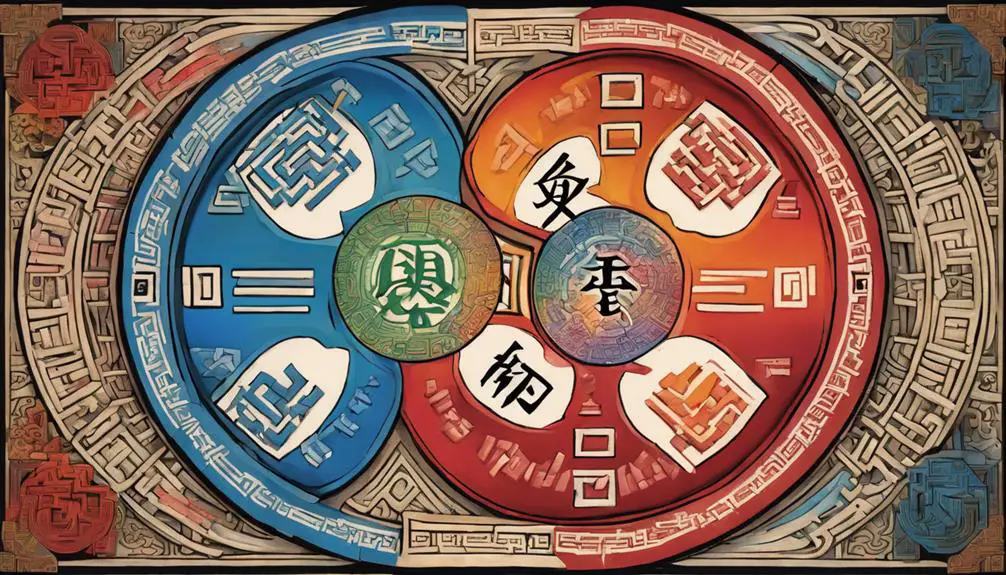
To fully appreciate the influence of the Later Heaven Bagua, it's essential to understand the Bagua trigrams that serve as its foundational elements. These trigrams, a group of three lines, each either broken or unbroken, represent fundamental concepts in nature, human behavior, and the cosmos. Understanding the trigram interpretations is crucial to grasping the complexity of the Bagua's evolution.
Each trigram is unique, symbolizing elements such as heaven, earth, fire, water, mountain, wind, thunder, and lake. The unbroken lines stand for yang, the dynamic and masculine principle; the broken lines represent yin, the receptive and feminine principle. The arrangement of these lines within the trigram further deepens the interpretation, offering a glimpse into the intricate philosophy underpinning the Bagua.
As you delve deeper into the study of Bagua trigrams, you'll realize that they're not static, but rather mutable symbols that embody change and transformation. This dynamism reflects the core belief of the Bagua's evolution: that life is a constant flow of energy and change. So, when exploring the Later Heaven Bagua, remember, understanding these trigrams is the key to unlocking its profound meanings.
Symbolism in the Later Heaven Bagua
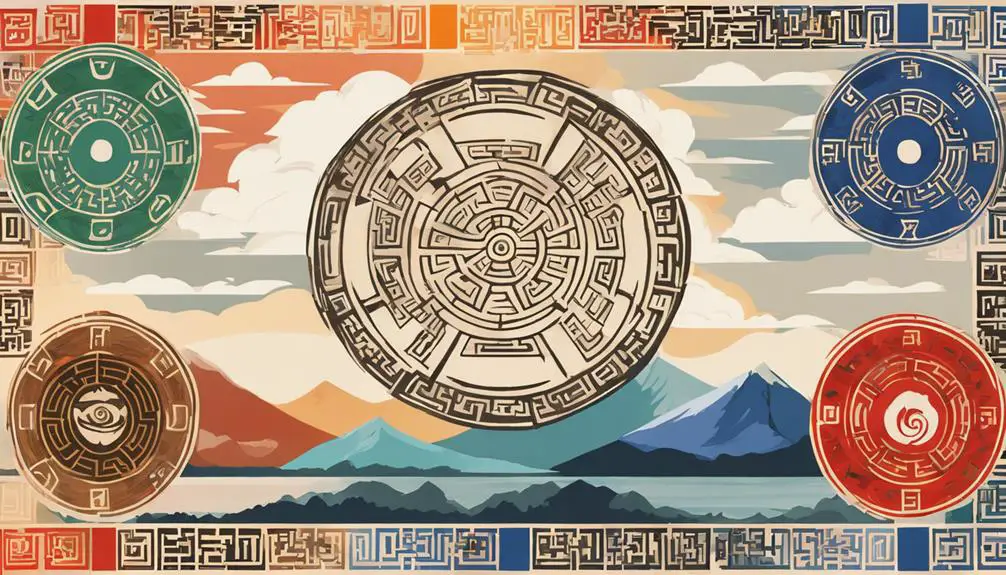
Peering into the Later Heaven Bagua, you'll uncover a wealth of symbolism that further illuminates the philosophy and teachings of this ancient system. The Bagua colors, for example, aren't random hues. Each color signifies a particular aspect of life, embodying its essence. Red represents the South and stands for fame and recognition, while black in the North signifies career and life path. Each color, in its placement and meaning, tells a story of balance and harmony.
Then, there's the profound Heaven Earth duality, a fundamental concept in Chinese philosophy. This duality is encapsulated within the Later Heaven Bagua. The Heaven Trigram, depicted as three unbroken lines, signifies the creative force and energy of the universe. In contrast, the Earth Trigram, shown as three broken lines, represents receptivity and nurturing. Together, they express the interplay of active and passive forces, revealing the interconnectedness and constant flux of all things.
In essence, the Later Heaven Bagua is a symbolic map, guiding you to deep insights about life's cycles and patterns. It's a tool that, when understood, can help you navigate life's mysteries with more wisdom and clarity.
Practical Applications of Bagua
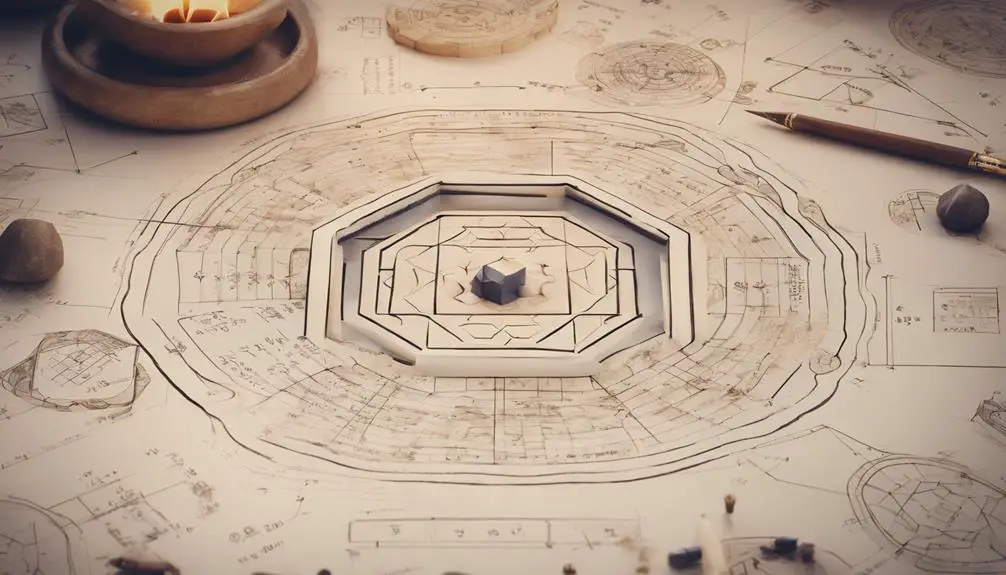
While the Later Heaven Bagua's symbolism offers a deep understanding of life's patterns, you can also use it as a practical tool in various aspects of daily living. One such application lies in Bagua Healing Techniques. These techniques are rooted in the philosophical concepts of the Bagua and aim to restore balance in your life. They involve meditative practices and physical exercises that help align your energy with the universe. They're not just about physical healing but also about emotional and mental well-being.
Bagua is also the foundation of a unique form of martial arts – Bagua Martial Arts. Unlike other martial arts, Bagua Martial Arts aren't about brute force. They're about understanding the flow of energy, the interplay of yin and yang. Practicing Bagua Martial Arts can improve your physical strength, agility, and endurance. But more than that, it can also enhance your focus, patience, and mental resilience.
The Bagua in Taoist Cosmology
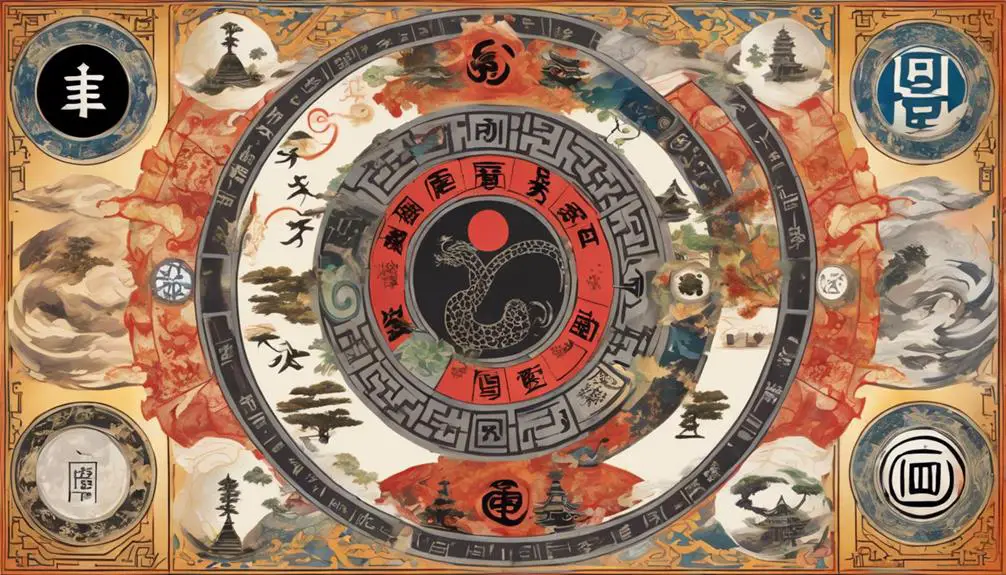
In Taoist cosmology, you'll find the Bagua serving as a fundamental symbol, reflecting the universe's dynamic balance and constant change. This ancient symbol encapsulates the Taoist Cosmology Evolution, which believes in the interplay and interdependence of opposing forces and principles. It's not just a static symbol; it's a living, breathing representation of the universe's constant flux.
Now let's delve into Bagua Meditation Techniques. These techniques align with the Bagua's overarching philosophy, promoting balance and harmony in one's life. By meditating on the eight trigrams, you're essentially tapping into the universe's energy flow, cultivating an awareness of the natural cycles of change. It's a powerful tool for inner transformation and spiritual growth.
In essence, the Bagua is more than just a symbol; it's a mirror reflecting Taoist cosmological principles. It's a roadmap for understanding the universe and our place within it. By integrating the Bagua into your meditation practices, you're not just fostering personal well-being. You're also embracing a powerful symbol that encapsulates the dynamic, ever-changing nature of the cosmos. So, delve into the Bagua, and let it guide you on your journey towards balance and harmony.
Later Heaven Bagua and Feng Shui
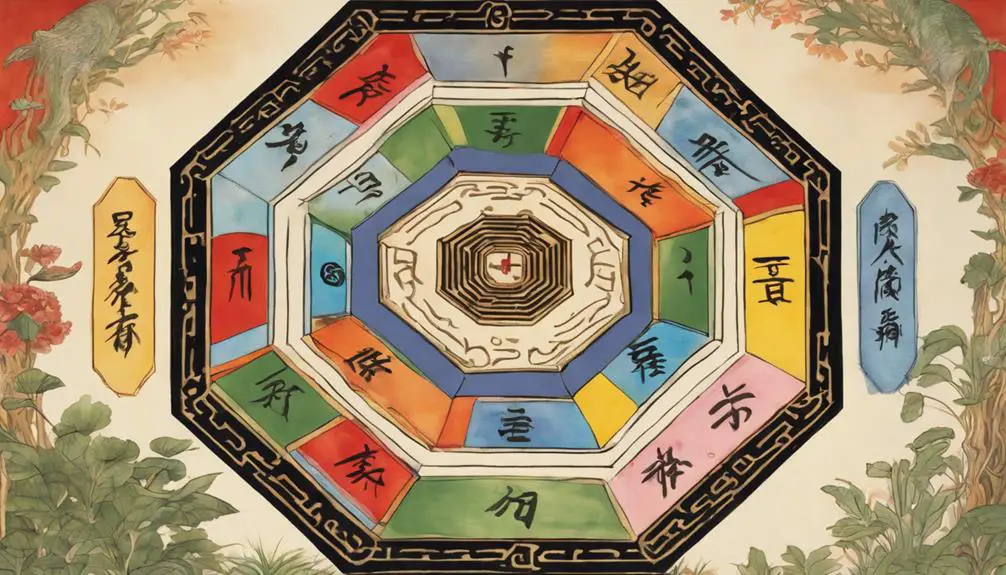
Let's now turn the spotlight on the Later Heaven Bagua, a crucial aspect of Feng Shui, which serves as a guide in harmonizing your environment with the forces of the universe. This complex system is often used in architecture, helping to align buildings and spaces with positive energy, or 'Qi'. By considering Bagua in architecture, you can create a space that nurtures wellbeing and prosperity.
Each of the eight areas, or 'guas', in the Later Heaven Bagua corresponds to a specific aspect of life, such as wealth, health, or relationships. These areas also align with certain colors, known as the Bagua color significance, adding another layer of depth to this practice. For instance, the North, associated with career and life path, corresponds with the color blue. Thus, you might incorporate blue accents in the northern area of your home or office to foster career growth.
Understanding the Later Heaven Bagua isn't about rigid rules, but about creating balance and flow in your environment. The colors and spatial arrangements serve as a guide, not a strict blueprint. It's a holistic system that can help you design spaces that resonate with your personal energy and aspirations.
Frequently Asked Questions
How Does the Later Heaven Bagua Relate to Other Philosophies or Religions Outside of Taoism?
In exploring other philosophies or religions, you'll find intriguing parallels with Bagua. Look at 'Bagua Versus Buddhism'. Both share concepts of balance and continual change.
Also, consider 'Heaven Bagua in Christianity'. Remarkably, you'll find symbolic similarities in the Christian Trinity.
Are There Any Contemporary Interpretations or Adaptations of the Later Heaven Bagua?
Yes, you'll find contemporary interpretations of Bagua in areas like architecture and design.
Bagua architecture, for instance, uses its symbolic meanings to enhance the flow of energy in living spaces. Its symbolism also influences art, with elements representing different life aspects.
However, these modern adaptations don't always maintain the original philosophical context, leading to variations in interpretation and application.
What Role Does Meditation or Mindfulness Play in Understanding and Applying the Later Heaven Bagua?
In understanding and applying meditation or mindfulness techniques, you're tapping into the core of Bagua visualization techniques. You're not just passively observing, but actively engaging with your emotional health.
This practice lets you explore your mind-body connection, cultivating a deeper understanding of yourself. It's about noticing and acknowledging your feelings, not judging or trying to change them.
This mindful approach can have a profound impact on your emotional health.
Are There Any Famous Historical Figures or Scholars Known for Their Work With the Later Heaven Bagua?
Yes, there are several noted figures who've delved into the Bagua. King Wen of Zhou is a prominent one. He's credited with the development of Bagua's influence on architecture and its symbolism in art. His interpretations of the Bagua trigrams are a cornerstone in Feng Shui, influencing design principles.
Additionally, the scholar Shao Yong is famous for his work with the Bagua, particularly his creation of the later heaven sequence.
Can the Principles of the Later Heaven Bagua Be Applied Beyond Personal and Spiritual Development, Such as in Business or Educational Contexts?
Absolutely!
You can apply the principles of Bagua in leadership and business strategies. It's about balance, harmony, and understanding interconnectedness.
You might consider Bagua inspired innovation in educational contexts too. Imagine using its principles to create dynamic, holistic learning environments.
It's not just about personal and spiritual development; it's a philosophy that can permeate every aspect of life, including professional and educational realms.
Conclusion
You've journeyed through the origins, symbolism, and practical applications of the Later Heaven Bagua.
It's clear that this powerful Taoist tool transcends simple decoration, becoming a guiding force in Feng Shui and life management.
By understanding its trigrams and its role in cosmology, you've unlocked a deeper connection to the world around you.
Remember, the Bagua's wisdom is a lifelong companion that can continually guide you in harmonizing with the universe's energies.

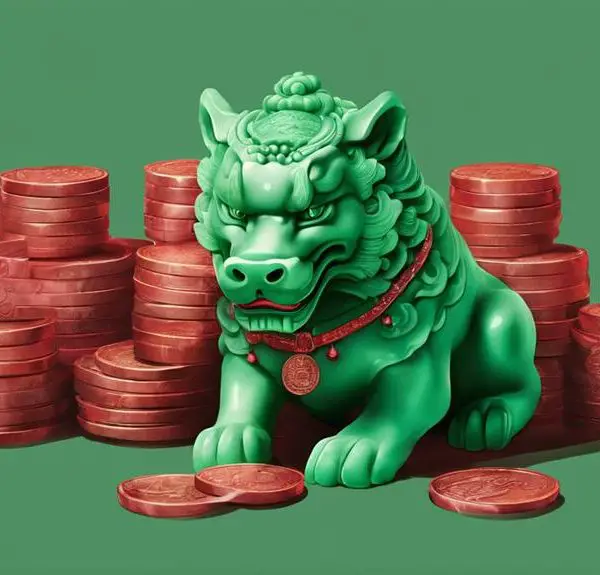
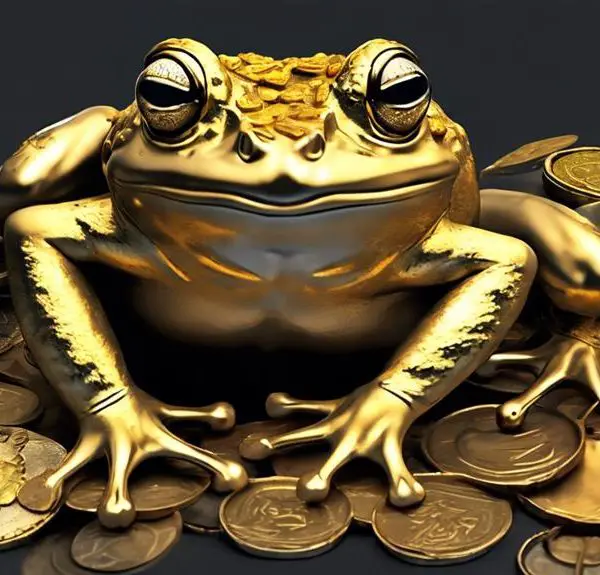
Sign up